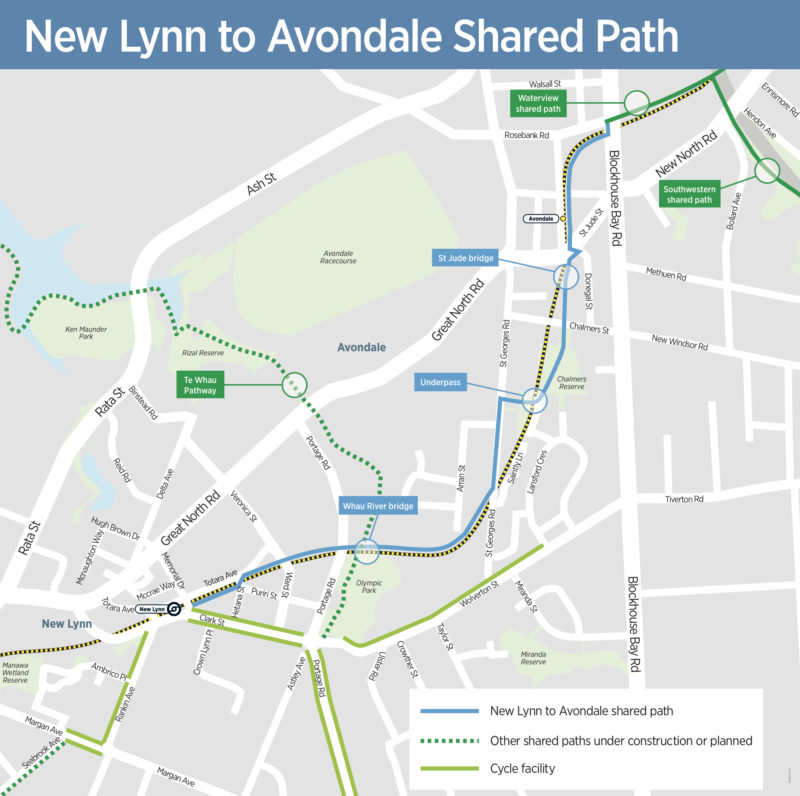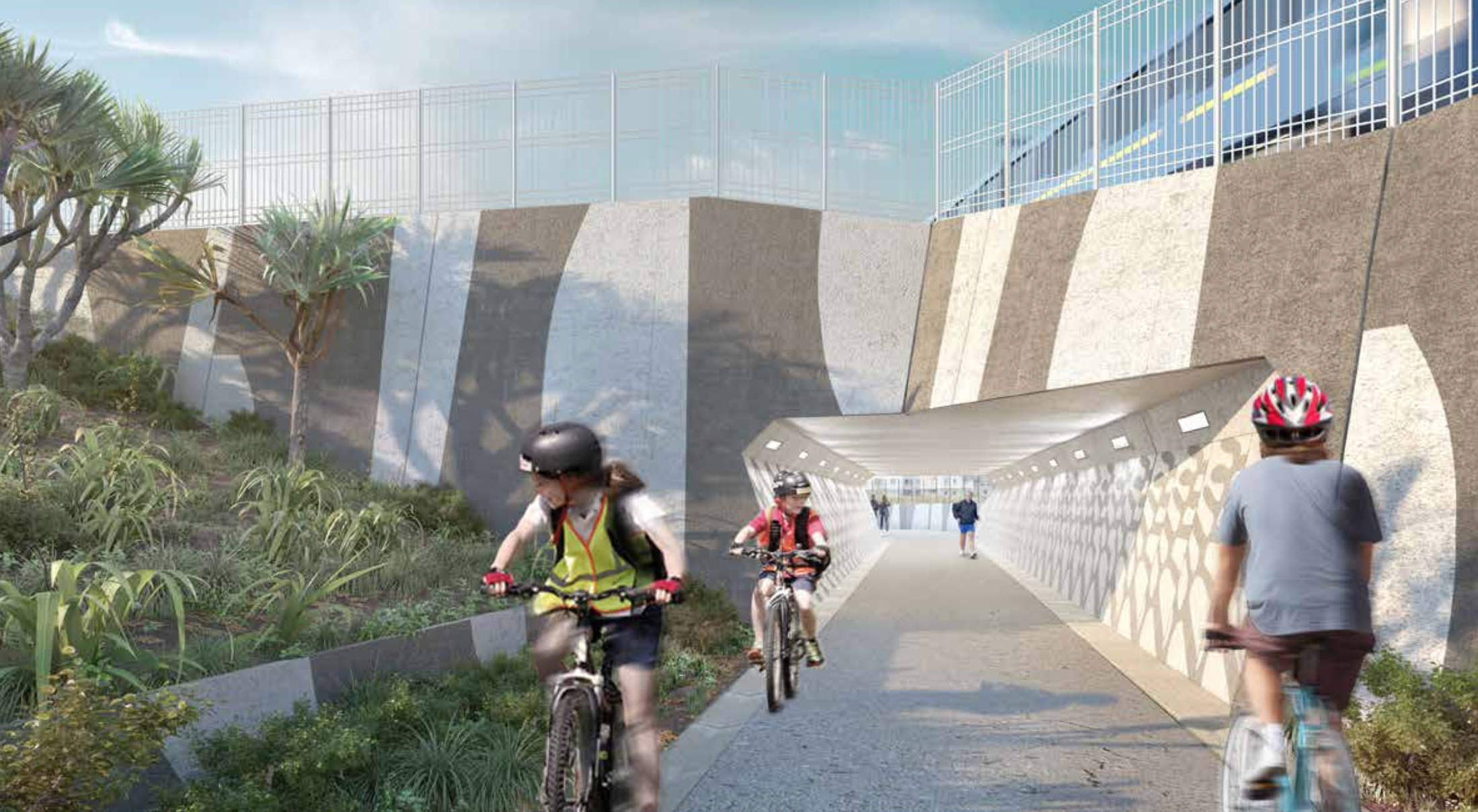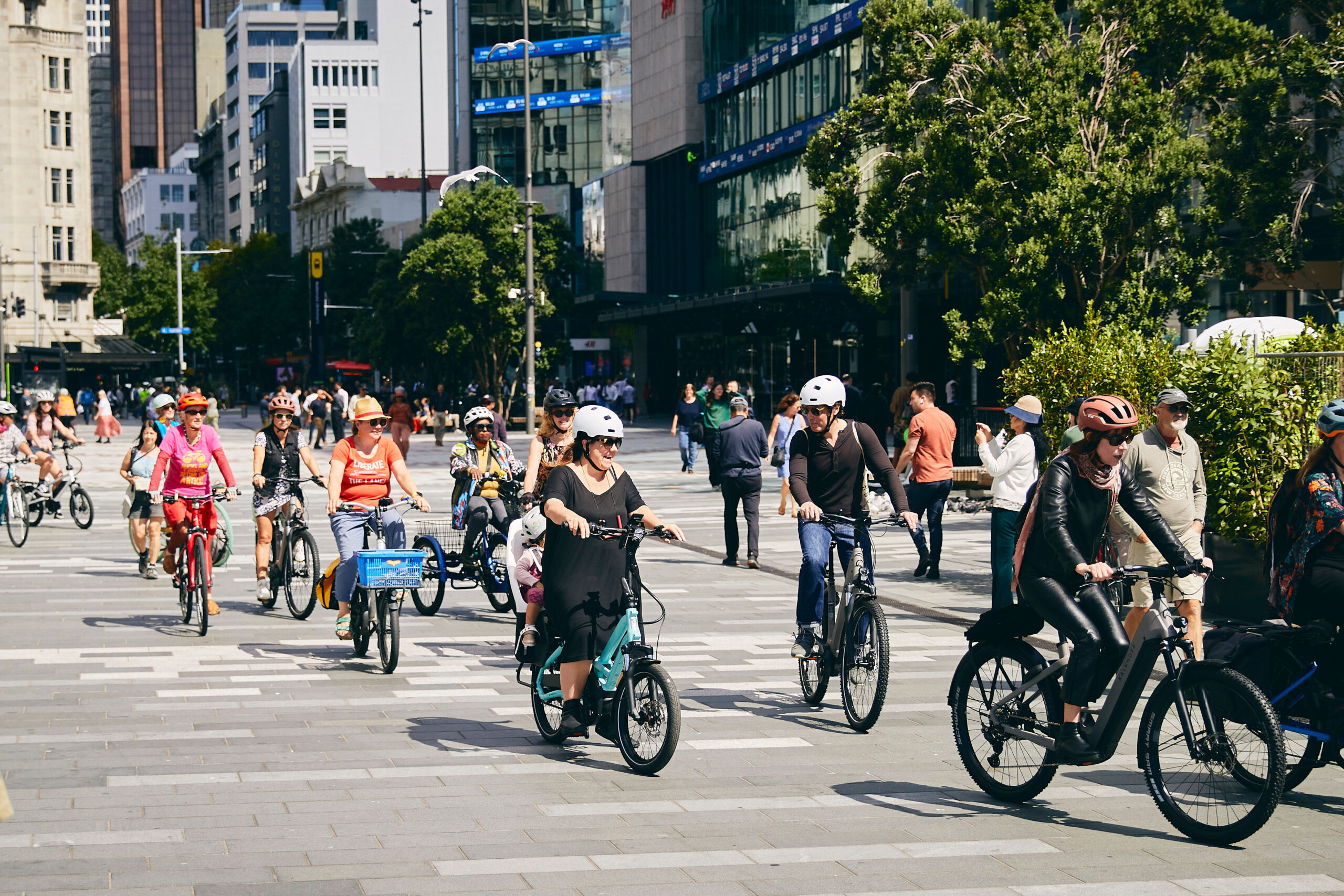Been wondering what’s happening with the New Lynn to Avondale ‘rail trail’ shared path project? So have we. Our Westie correspondent Sam Finnemore takes a look back over the story so far, what’s hopefully coming next, and how it fits into the bigger picture out west.
A lot’s changed since Easter 2016, both in New Zealand and internationally, for better and for worse (with no particular order implied!). But let’s focus just on developments for bikes right here in Auckland.
Two years ago, the Lightpath had been open and blowing Aucklanders’ minds for just a couple of months. Right at the heart of downtown, the Quay Street protected cycleway was still a few weeks away from opening. And the first few sods had just been turned on the Waterview shared path, to run over Oakley Creek through Unitec and Phyllis Reserve to the Avondale train station.
This post literally starts where that Waterview path now ends, because back in mid-April 2016, AT also opened consultation for the New Lynn to Avondale shared path – a new, off-road connection to bring people on bikes all the way from Waterview to the heart of New Lynn, beside the Western rail line.
Building steam
Again, 2016 feels like a long time away, but regular readers will remember our coverage at the start of the New Lynn to Avondale consultation.
Out in the wider bike community, reactions included some disappointment at the proposal of a ‘rail trail’ rather than on-road protected routes (more on this later), plus the usual technical issues and concerns that Bike Auckland and others subsequently raised with AT – but there was also plenty of excitement about a new, safe link through a part of Auckland crying out for better bike connections.
The consultation ended with 143 responses and lots of feedback for AT to consider. Just before the opening of the Waterview shared path in October 2017, AT came out with their feedback and an updated design based on responses received.
We summarised the post-consultation changes at the time. The biggest one was the addition of an underpass at the St George’s Road rail crossing, at the behest of KiwiRail who are keen to avoid ‘new’ level crossings over rail lines as train frequencies in Auckland increase. Hard to argue with that. The updated route was also slightly shortened at the western end, finishing up at New Lynn Station rather than Rankin Street a bit further out.

At the time, AT announced that works would begin in ‘the first quarter of 2018’, and Bike Auckland had hopes at the time that preparatory work would actually be underway from late 2017. With the Waterview path by this point open for business, it was looking like a happy Christmas and New Year ahead.
Switching tracks
Now let’s skip back to the future. With Queen’s Birthday already the next long weekend on the horizon, we went straight to the source for an update on progress. AT’s David Nelson (Group Manager of Major Projects) kindly answered some of our questions.
In short: since sketching out the general design post-consultation, AT has been following [clarification update 17 April 2018: AT had been considering] a procurement method called early contractor involvement (ECI) to get the path designed and built. As the name suggests, using ECI means a contractor is involved right from the concept stage of a project.
ECI is often used for projects which are relatively cheap (by infrastructure standards), where new requirements might need to be added to the build over time, or where there are tricky design questions that construction know-how can help solve.
Having that expertise early on does add cost, however – and with the addition of some expensive new elements to the project, including the underpass at St George’s Road, AT have decided not to pursue the ECI approach, for cost reasons.
They’re now reviewing the design as a whole, and will then complete the remaining detailed design work themselves before going out with a more straightforward traditional tender for construction to get it all built. Per the Business Report for AT’s next board meeting, the Design and Constructability Review should be completed by the end of April.

Also: the various shiny new bits have also pushed the project budget up past the $20 million threshold for AT Board approval. So it’ll now go in front of the great and good in May for their signoff – after which (fingers crossed) the tendering process will start, contracts for the build will be awarded, and work can start.
What’s next?
Advice from David suggests that the first sod-turning could happen as soon as early winter – that’s in June, by our calendar – with the path fully completed in 2020.
That isn’t far off what was expected under the previous tendering process. But it all hinges on the project getting timely approval, and any design issues being quickly spotted and resolved – and that’s before any actual construction delays kick in (and we’ve seen unexpected issues crop up with path construction along the Western Line before).
It’s also worth remembering that under the Urban Cycleway Fund launched in 2014, this shared path was slated for completion in the 2017/18 financial year – meaning that, had things gone a bit differently, we might already have been riding it by now.
The bigger picture
We’ve gotten a strong message from David and the team at AT that they’re as keen to for movement on the New Lynn to Avondale path as we are – and that their change of procurement approach is all about getting the best possible results on time and within the available budget.
At the same time, the new Government Policy Statement on transport also suggests there might be more money forthcoming to pay for this project in its new, more expensive form, as well as other walking and cycling initiatives around the country.
So there’s cause for optimism about the New Lynn to Avondale path – but also good reason for concern on several fronts, including whether the increased costs might still prove a bridge (or underpass) too far for the AT Board, and whether design or construction issues might affect the path’s completion date or the quality of the final result.
And quality is key, because this project and the planned Te Whau Pathway will be carrying the weight of safe cycling demand in this part of Auckland for several years yet.
We’re often asked to support on-road protected cycleways as alternatives to paths like this – and honestly, it’s something we would love to see happen. But when AT last consulted on general cycling improvements in this area, improvements on arterials like Great North Road were kicked into touch for at least a decade, due to budget constraints and ‘competing demand between different modes of transport’.
Two years later, neither of those factors have shifted enough to make high-quality on-road paths a happening thing in this part of Auckland, at least not before 2020.
Not that we’ve given up – far from it! But for now we’ll continue to put our weight behind the New Lynn to Avondale shared path, keep a close eye on progress, and hopefully see its success become a green light for more of the improvements we want (and need) to see for bikes out West.
— Sam Finnemore
Want to help make Auckland better for bikes, out West and elsewhere? Keep an eye on our website for a heads-up about projects and upgrades that need your support – and you can also keep an eye on Auckland Transport’s cycling project homepage.



